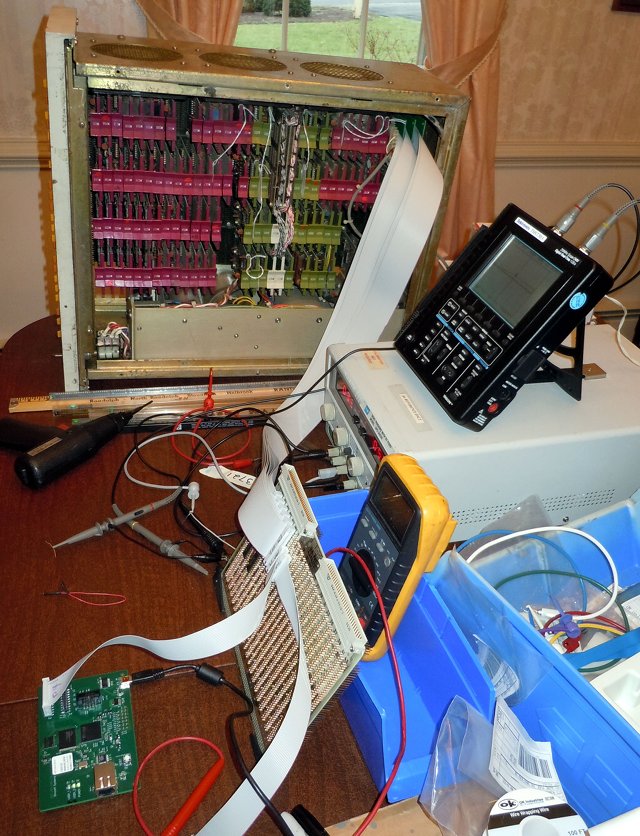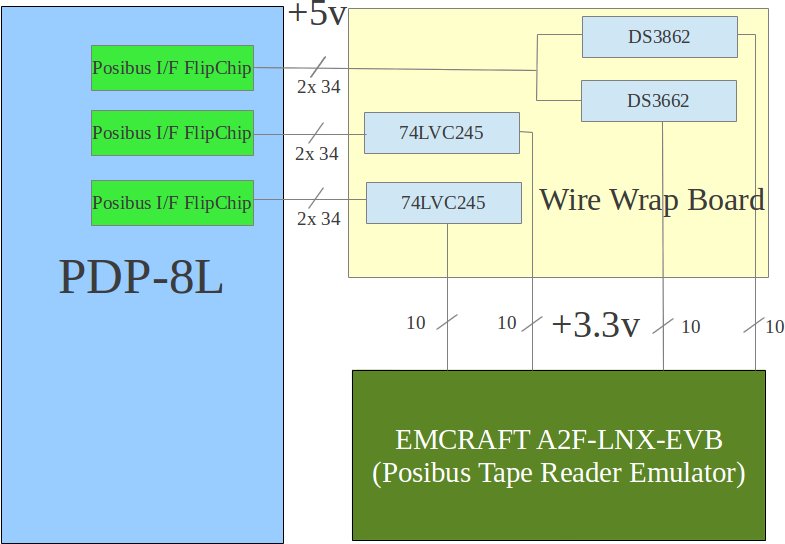According to Wikipedia, Digital Equipment Corporation (DEC) PDP-8 was the first successful commercial minicomputer, and was introduced in March 1965. Mike Thompson, working at Rhode Island Computer Museum (RICM), has restored a PDP-8/L system that was sold between 1968 through 1971. The system can be expanded with 4K of core, a paper tape reader (PR8/L), and/or a punch (PP8/L) controller. But the tape reader is not available anymore, so Mike decided to designe a Posibus peripheral (Tape Reader) emulator using a board with an FPGA + micro-controller. The easiest way to perform this task was to get an SoC that comes with an MCU and a FPGA to avoid having to create an FPGA <-> MCU interface. This is why he chose Emcraft Linux SmartFusion Evaluation Kit featuring a Microsemi Smartfusion cSOC with a Cortex M3 core and an embedded FPGA. The whole setup is shown below.

Three FlipChip interface boards are fitted inside the PDP-8/L, and connected to a Wire-Wrap board via 3 pairs of 34-pin ribbon cables. The signals then go through 2x 74LVC245 ICs for +5V (Posibus) to +3.3v (Emcraft board) conversion to be handled by Emcraft boards. Signals from Emcraft boards go through DS3862 and DS3662 (+3.3v to +5v) back to PDP-8/L Posibus interface. A simplified connection diagram is shown below.

That’s the hardware setup. On the software side, Mike programmed the FPGA to handle the Posibus signals, and emulate the tape reader controller. A Linux driver and application running in uClinux was also developed with the help of Emcraft Systems engineers. The Linux application reads an image of a paper tape from flash memory and writes it to the paper tape reader controller logic in the FPGA via the driver.
This setup is currently working, and Mike will soon release the documentation and software on RICM’s PDP-8/L restoration page. I’ll update the post / comment once the files are available.
The Emcraft SmartFusion evaluation board has enough I/O to emulate 8-bit devices that send data to the processor, but it does not have enough I/O to support receiving data from the processor. Therefore, a second generation of the Posibus Peripheral Emulator will use the Emcraft SmartFusion SOM Starter Kit which provides more I/O, and will allow the emulation of any Posibus peripheral such as disks and tapes.
You can get further technical details on RICM’s Posibus Peripheral Emulator page.
Disclosure: This post has been sponsored by Emcraft Systems.

Jean-Luc started CNX Software in 2010 as a part-time endeavor, before quitting his job as a software engineering manager, and starting to write daily news, and reviews full time later in 2011.
Support CNX Software! Donate via cryptocurrencies, become a Patron on Patreon, or purchase goods on Amazon or Aliexpress




